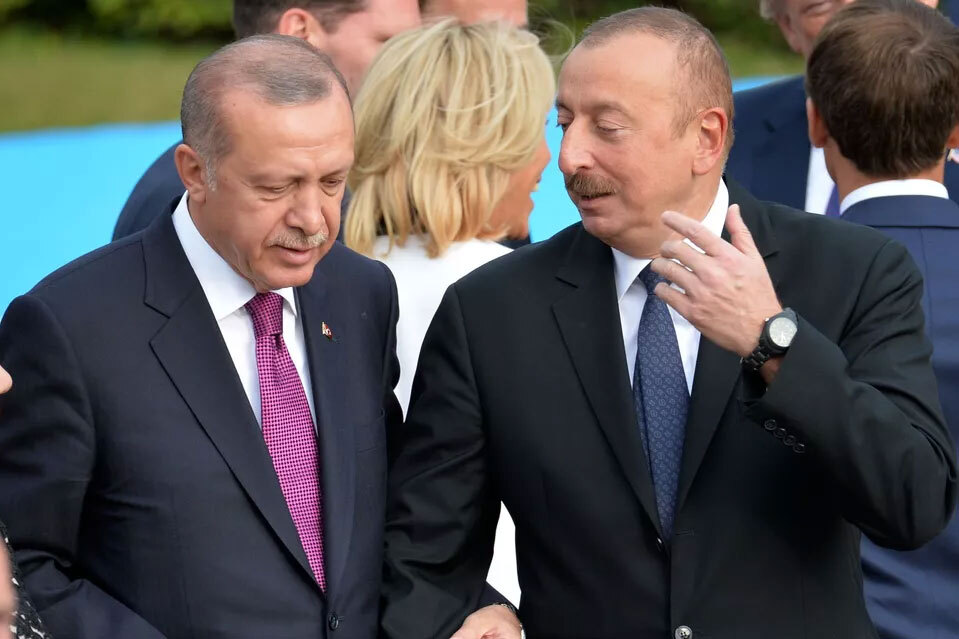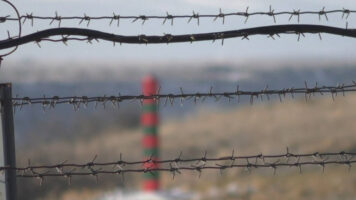What is Azerbaijan’s goal in promoting the fictional idea of “Western Azerbaijan”?
04.06
2025
Part Two
Turkey’s and Azerbaijan’s Goals: Turkey, of course, is the third-largest beneficiary in the Caucasus after Russia and Iran. Ankara’s plans to expand eastward date back to the Ottoman era. Even 110 years after the genocide, nothing has changed. Turkey is undergoing yet another transformation of national identity, and this change cannot happen at the expense of Europe, but rather the regions where states are weak economically and in terms of security, which is fertile ground for Turkish expansion. These regions include Syria, Armenia, Lebanon, partly Iraq, and the Balkans, where Turkish infiltration or intervention does not have a military character but operates through soft power — economy, cultural, and linguistic policies. The largest platform for Turkish policy in Europe is Hungary — Magyarország — which is also a Turkic ethnic entity. To use European platforms for its expansion plans, Turkey has invested billions in Hungary, where Prime Minister Orban, known for his dictatorial reputation, has repeatedly demonstrated his Turkophile stance and openly advocates for pro-Turkish policies, acting as Ankara’s voice in Brussels.
Budapest hosted an informal summit of leaders of Turkic states, where Erdoğan and Aliyev also spoke. Erdoğan’s speech was very clear: “The tragedies in Cyprus, Nagorno-Karabakh, Bosnia, and today in Gaza remind us of the necessity of thinking beyond our borders. The launch of the Middle Corridor, which would ensure secure and uninterrupted communication between the East and the West, and which is being brought to the forefront as a strategic route, is very important.” Further analysis is unnecessary.
Turkey places immense importance on the cooperation of Turkic states, which has strategic significance. Ankara seeks to ensure the engagement of all member states in the organization, aiming for the success of the Middle Corridor, with the goal of realizing neo-Ottoman ambitions through mutually beneficial agreements, establishing a significant economic and military-political presence between Europe, Russia, and Iran. Here lies the basis for the discourse that Azerbaijan has been actively promoting over the past 7-8 years. It is the so-called “Western Azerbaijan” thesis, which appears unrealistic but is strategically significant in the long term.
If we objectively analyze the issue without emotions, Baku’s goal is the settlement of 300,000 Azerbaijanis in Armenia. The idea of “Western Azerbaijan” is a fabricated concept, the idea of the Azerbaijani elites to have an invented homeland, with which they want to establish themselves as a nation-state. This process began in the months following the Artsakh movement—from Baku to Sumgait and Maragha—organizing the genocide of Armenians in Azerbaijan, followed by war and anti-Armenian rhetoric, which starts from kindergarten, continues through school curricula, reaches universities, and then the so-called “academy,” gaining scientific legitimacy and becoming part of political discourse and doctrine. Aliyev’s regime is not naive; it is actively using these theses for internal mobilization and to neutralize opposition.
In this context, we should not succumb to emotions; it’s necessary to adopt a balanced, firm, and unwavering stance through concrete actions. The “Western Azerbaijan” thesis is merely a geopolitical tool and has five main goals:
- Continue psychological pressure on Armenia and Armenians in conditions of complete political and moral collapse—not ruling out the possibility of implementing such a plan.
- An additional bargaining chip in negotiations with Armenia. This is the result of our fatal mistakes since 1994, when, within the Minsk Group framework, Armenia failed to raise the issue of Shahumyan in negotiations.
- It is a manipulated game by Aliyev and Pashinyan, aimed at providing Pashinyan with internal political leverage by artificially presenting this issue as a threat — a pretext for him to claim that if the Armenians of Karabakh return, then 300,000 Azerbaijanis should also return to Armenia, forgetting about the over 400,000 Armenians living in Azerbaijan. Pashinyan will then portray himself as a “white knight,” claiming to have negotiated a compromise with Azerbaijan and exploiting this fake issue politically.
- It is a pressure tactic to achieve the “Zangezur Corridor”: demand maximum concessions to get the minimum.
- It is a projection of Russian and Iranian vertical strategic influence. The Turkish-Azerbaijani tandem’s horizontal influence can be realized by pressuring the weakest point—the Armenian authorities, whose negotiating positions are weak and unable to counter.
So, what is Azerbaijan’s goal in promoting the fictional idea of “Western Azerbaijan”? Through this, Azerbaijan aims not only to claim territorial rights but also to transform into a force that seeks to revise and rewrite history and national borders, just like the Islamic State terrorist organization. Baku’s policies resemble those of radical terrorist groups.
In this context, is it realistic to expect positive reactions from global and military centers, regardless of whether the anti-national Pashinyan junta or someone else is at the helm of power in Armenia?
Geopolitical Situation: Let’s try to analyze the issue from a global geopolitical perspective, based on the positions of three major powers.
- China: China officially adheres strictly to the principle of territorial integrity, especially due to its vulnerabilities in Xinjiang, Taiwan, and Hong Kong. Therefore, Beijing cannot support initiatives that declare an nationalist claim over another state’s territories, in this case, Armenia. However, if the operation of the Middle Corridor route from China to Europe is disrupted, we may witness Beijing’s silent stance. China is determined to maintain its economic or transit interests in the South Caucasus.
- Russia: Russia is interested in keeping Armenia and Azerbaijan, which won the 44-day war, in its sphere of influence with controllable security. However, implementing the “Western Azerbaijan” plan—redrawing borders—would set a dangerous precedent in the North Caucasus, Ukraine, or Belarus. Especially raising such ideas near the Russian base in Gyumri contradicts Russia’s strategic interests. In case of such scenarios, Russia would try to delay or disrupt the plan through political pressure օռ uncertainty․ However, if Pashinyan attempts to legitimize this Azerbaijani-Turkish narrative, Russia will act in its own interests, as it did after the Prague negotiations and statements, justifying its withdrawal from Nagorno-Karabakh and the failure of its peacekeeping mission.
- U․S․: Washington will not officially support such plans, as they violate the principle of inviolability of borders and undermine democracy and foreign policy approaches based on international law.
How realistic are these positions? Given the current global uncertainty, only what a collapsing state internally allows is realistic. The Pashinyan government has depoliticized the generation, paralyzed diplomacy, and its security architecture portrays Armenia as an aggressor and Azerbaijan as a legitimate claimant. In such conditions, continuing to tolerate Pashinyan’s rule makes these plans seem plausible—not because of Azerbaijan’s strength, but due to Armenia’s weakness. Remember, at any time, the enemy can declare its so-called “historic rights.” We may pretend to sleep, ignore, mock—but this only weakens us and diminishes vigilance. Enemy schemes only materialize when the nation’s instinct for survival is numb and self-awareness is abandoned from within—lacking leaders, elites, and purpose.
In this context, let’s analyze Lavrov’s visit to Yerevan, alongside Iran’s deputy defense minister’s arrival. These short diplomatic contacts send clear messages, coded signals for three parties: the West, Turkey, and Pashinyan, who serves Turkey’s interests. The main hypothesis is that Armenia’s leadership is engaging in a new deal. Lavrov’s and Iran’s high-ranking official’s visits come as coordinated efforts to neutralize Turkey and Azerbaijan’s expanding influence in the South Caucasus. Currently, Moscow’s and Tehran’s interests align, but there is a reservation regarding the potential launch of the so-called “Zangezur Corridor” through Armenian territory. It’s possible that Pashinyan has agreed to make two key concessions: to step back from Euro-integration plans, and to strengthen Russian influence in Syunik Province by handing over control of the “transport corridor” to the FSB. In this scenario, Armenia’s sovereignty would be partly sacrificed, while gaining political protection. Pashinyan will present this as a victory, claiming he avoided the corridor. But in reality, the following will happen: the FSB will be established in Syunik; the sovereignty of Armenia, which has dependent security, will be controlled by the Russian special service, secondly, in exchange for this concession, it will be possible to reproduce Nikol’s power, with a loyal approach to Moscow, and Nikol will strengthen his positions inside Armenia.
But a second scenario cannot be ruled out either. Russia and Iran might simply turn Pashinyan into a tool again—to temporarily cut Armenia off from the western-oriented path, and once that goal is achieved, Moscow could shift its support and back a more reliable and predictable partner who can—with Russian support—actually keep Syunik as a strategic buffer—against Turkish and Western influence. Moreover, such a person is more favorable to Russia, because the Artsakh issue is a volatile firecracker.
What does all this mean for us? Today, Armenia has become one of the key subjects of regional big deals, but not from the position of a sovereign actor. Nikol is trying at all costs to maintain power by selling off pieces of sovereignty to external partners. In this process, the security front of Syunik is turning into a field of strategic maneuvers where Moscow and Tehran seek to strengthen their presence—at the expense of the West and Turkey.
Syunik does not begin at Lake Sevan nor end at the Meghri crossing. It is not only the backbone of Armenian statehood but also a crossroads of several civilizations, a meeting point of interests of several states. This government has turned Syunik into a global political exchange, where Turkey and Azerbaijan are buying and selling shares—virtually.
The greatest tragedy is that we have been turned into cheap pawns, and now our rights and sovereignty are being negotiated, with the only solution being the implementation of a vertical diplomatic vector. We believe that the interests of Moscow and Tehran currently align with Armenia’s national and state interests.
Will this consensus stand the test of time? Will Pashinyan hinder this regional architecture, which is a forced combination? Refusing it would be political suicide. But we believe Nikol will secretly continue to strengthen Turkish-Azerbaijani influence in Armenia—if, of course, he and his team remain in power until then.





